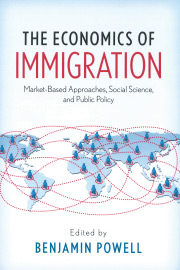President Trump has signed an executive order halting legal immigration to the United States for 60 days. He claims the order will help protect us from the COVID-19 virus pandemic and protect the jobs of U.S. workers. He’s wrong on both counts.
Immigration had already nearly ground to a halt because of earlier actions Trump had taken. The admission of refugees was halted on March 19. Few visas for would-be immigrants have been processed since March 20, when the State Department canceled most appointments for foreigners at U.S. consulates and embassies. With international flights curtailed and the Canadian and Mexican borders closed, there were already few ways for immigrants to enter the country.
The new executive order halts the issuance of green cards for permanent residency in the U.S. Last year, the U.S. government issued approximately 469,000 green cards. That number was down about 13% from 2018 and is sure to fall further this year.
It’s not clear why limiting the already small numbers of immigrants entering the country would do much to slow the spread of a disease that already is widespread in the U.S. But even if there are legitimate fears of immigrants increasing the spread of the COVID-19 virus, the solution would be to quarantine them upon entry, rather than to prohibit them from coming.
Rahm Emanuel advised President Barack Obama to “never let a crisis go to waste” during the financial crisis a decade ago. Trump seems to have taken that lesson to heart and is using the coronavirus pandemic as an excuse to implement anti-immigrant policies that he’s been touting for years.
Trump revealed his ill-informed motives for the order during his April 21 press conference, saying, “By pausing immigration, we’ll help put unemployed Americans first in line for jobs as America reopens,” and that “It would be wrong and unjust for Americans laid off by the virus to be replaced with new immigrant labor flown in from abroad. We must first take care of the American workers.”
Trump’s claims that immigrants displace or otherwise harm the earnings of American workers were wrong during the 2016 election, and they are equally wrong today. Economists have researched and debated the labor market impact of immigrants on native-born Americans for decades, and their research, much of which is summarized in a National Academy of Sciences’ 2017 report on immigration, does not support Trump’s claims.
Rather than take jobs from native-born workers, economists have found that immigration changes the mix of jobs done by the native-born, with immigrants replacing them in some industries, while new jobs are created in other industries, with the total number of jobs increasing by roughly the number of new immigrant workers.
Most native-born Americans don’t directly compete with immigrant labor because immigrants generally have different skill sets than most of us. Only those without a high school diploma are likely to compete for jobs with low-skilled immigrants. But even these workers, economists find, typically experience only small and temporary decreases in wages.
Although many realize that a disproportionate number of immigrants are low-skilled, they often don’t realize that a disproportionately large number also are highly skilled. This is particularly relevant during the COVID-19 virus pandemic.
A recent study published in the Journal of the American Medical Association found that nearly 17% of healthcare providers and 29% of physicians in the U.S. are foreign-born. Resident immigrants probably would be providing even more healthcare services if state licensing boards didn’t discriminate against those who received their medical training abroad.
Rather than using the coronavirus pandemic as an excuse to limit immigration because of misplaced economic fears, a wiser policy would be to issue more immigration visas to healthcare providers worldwide and to encourage states to liberalize their medical licensing laws to allow these immigrants to practice medicine. Such a policy would improve both our wealth and our health.












